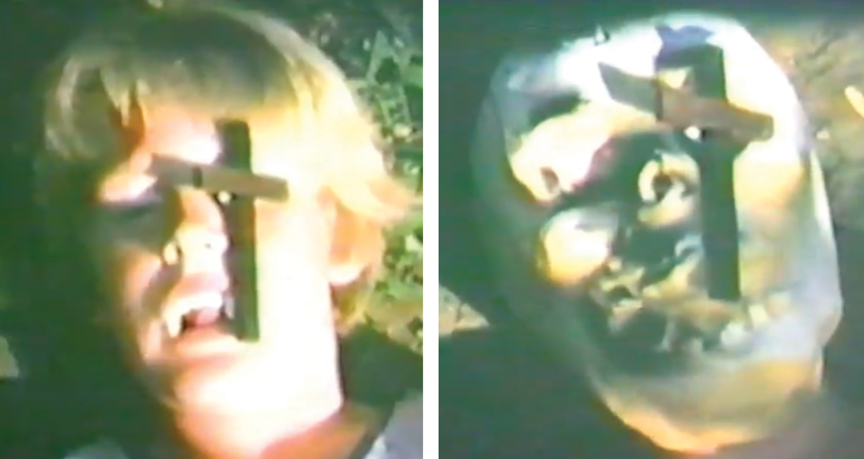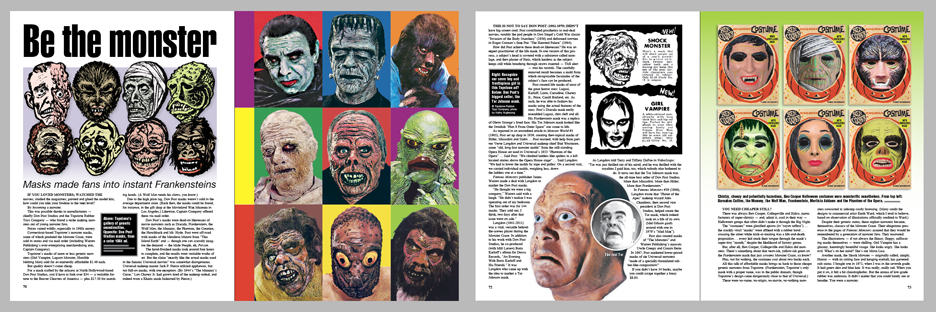From “Monster Mash: The Creepy, Kooky Monster Craze in America 1957-1972” (TwoMorrows Publishing) by Mark Voger

It’s no surprise that drunken costumed guests at Halloween parties can become brazen flirts … or that terminally shy kids turn into extroverts once they don the giant head of the team mascot.
Something changes when you put a mask on. Just ask Bruce Wayne or Peter Parker.
Masks were a huge thing during the Monster Craze. I pined away for the Don Post Studios masks, which cost a fortune in 1960s kid money, but were fascinating replicas of movie monsters. I’d seen the ads in Famous Monsters for years, but I’ll never forget the first time I saw them “in person.” It was at the Movieland Wax Museum in Los Angeles in 1972, the summer after I graduated eighth grade. The masks, all of them, were in Movieland’s gift shop (on high shelves, so as not to be molested by the lollipop-sticky fingers of tourists’ little brats). It was a revelation to see them for real. I later owned two of Don Post’s Tor Johnson masks (one was stolen, the other is in pretty bad shape), but never one from that “first string” of monsters.
I was the proud owner of a Shock Monster mask from Topstone (the cover boy for “Monster Mash”). At a gift shop in Detroit in 1970, I bought a skull mask (okay) and a devil mask (awful), and tried really, really hard to convince myself that they were cool monster masks. (That day, I also tried to buy playing cards with naked ladies on them, but the cashier busted me.) I used that skull mask in my 1971 Super 8 opus “Fury of the Vampire” to denote that the vampires, once vanquished, turned into skeletons. (Somehow, it looked a lot cooler when Christopher Lee did it in “Horror of Dracula.”) Watch “Fury of the Vampires.”
Masks made it possible for monster fans to become, ever so fleetingly, monsters themselves. Following are excerpts from the “Monster Mash” section on masks …
![Don Post Studios masks, from a 1965 ad. The same photos were used in a calendar issue by Don Post. [© Universal Studios; © Don Post Studios]](https://markvoger.com/wp-content/uploads/2015/03/MVCOM-MASKS-POST.jpg)
By becoming a monster.
This was possible thanks to manufacturers — chiefly Don Post Studios and the Topstone Rubber Toys Company — who found a niche making monsters out of young monster fans.
Prices varied wildly, especially in 1960s money.
Connecticut-based Topstone’s monster masks, some of which predated the Monster Craze, were sold in stores and via mail order (including Warren Publishing’s ever-enterprising merchandising arm, Captain Company).
Topstone’s masks of more or less generic monsters (Girl Vampire, Lagoon Monster, Horrible Melting Man) sold for an eminently affordable $1.49 each.
![A Topstone ad from 1961 spotlights the Shock Monster and the Girl Vampire, in iconic artwork by Keith Ward. [© Topstone Rubber Toys Company]](https://markvoger.com/wp-content/uploads/2015/03/MVCOM-MASKS-AD-224x300.jpg)
For a mask crafted by the artisans at North Hollywood-based Don Post Studios, you’d have to fork over $34 — a veritable fortune to the Beaver Cleavers of America — plus $17.50 for matching hands. (A Wolf Man needs his claws, you know.)
Don Post’s masks were dead-on likenesses of movie monsters such as Dracula, Frankenstein, the Wolf Man, the Mummy, the Phantom, the Creature, the Hunchback and Mr. Hyde. Post went off-road with masks of the Metaluna Mutant from “This Island Earth” and — though one can scarcely imagine the demand — the Mole People, eh, Person.
As reported in an uncredited article in Monster World #3 (1965), Post set up shop in 1939, creating then-topical masks of Hitler, Mussolini and Stalin … Post rescued, with help from partner Verne Langdon and Universal makeup chief Bud Westmore, some “old, long-lost monster molds” from the still-standing Opera House set used in Universal’s 1925 “Phantom of the Opera” … Said Post: “We climbed ladders like spiders to a loft located stories above the Opera House stage” … Said Langdon: “We had to lower the molds by rope and pulley. On a second visit, we carried individual molds, weighing less, down the ladders one at a time.”
![Chintzy, cheezy and potentially hazardous, Ben Cooper Halloween costumes were monsterific nonetheless. From top left: Barnabas Collins, the Mummy, the Wolf Man, Frankenstein, Morticia Addams and the Phantom of the Opera. [© Ben Cooper, Inc.]](https://markvoger.com/wp-content/uploads/2015/03/MVCOM-MASKS-BEN-300x255.png)
“He thought we were a big company,” Warren said with a laugh. “He didn’t realize I was operating out of my bedroom. The first order was for 144 masks. They sold out, I think, two days after that issue went on sale.”
Langdon (1941-2011) was a vital, versatile behind-the-scenes player during the Monster Craze. In addition to his work with Don Post Studios, he co-produced (with Milt Larsen) Boris Karloff’s album for Decca Records, “An Evening With Boris Karloff and His Friends.” It was Langdon who came up with the idea to market a Tor Johnson mask.
In Famous Monsters #39 (1966), Langdon wrote that “Planet of the Apes” makeup wizard John Chambers, then second vice president at Don Post Studios, helped create the Tor mask, which indeed took on a life of its own. (Mel Gibson goofs around with one in 1979’s “Mad Max”).
Post also created masks of “The Munsters” and Warren Publishing’s mascots Uncle Creepy and Cousin Eerie. In 1967, Post marketed lower-priced masks of six Universal monsters “made of a specially-formulated rubber-like composition!”
If you didn’t have 34 bucks, maybe you could scrape together a lousy $8.95.
You need cheaper still?
There was always Ben Cooper, Collegeville and Halco, manufacturers of super-chintzy — and, admit it, cool in their way — Halloween getups that often didn’t make it through the Big Night.
The “costumes” were glorified aprons (in “rayon taffeta”) … the crackly vinyl “masks” were affixed with a rubber band … crossing the street while trick-or-treating was a life-and-death proposition … every kid stuck their tongue through the mask’s super-tiny “mouth,” despite the likelihood of factory germs.
